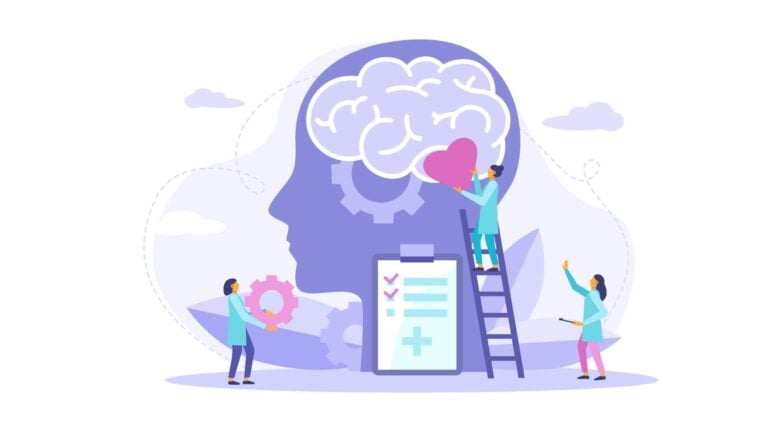There are many benefits of mental health days off work for both employees and employers. In this article, we cover everything employers should know about mental health days and how to add them to workers’ overall compensation.
According to the latest studies, mental health days off work promise improved productivity, reduced bottom-line costs, and increased morale and employee engagement. But even while recognizing these benefits, employers may be unsure of the best way to implement mental health days. Concerns around stigma and perception, privacy, logistics, cost, performance, communications, and compliance abound.
In this article, we look at the science of mental health days, plus their benefits and potential challenges for both employers and employees. We then explain how you can successfully add mental health days to your workers’ total compensation.
Key Takeaways
- Poor employee mental health costs businesses billions of dollars every year.
- Mental health days can help promote employee well-being, but only as part of a larger strategy.
- Some states have paid time-off laws that include mental health. Be sure to research your responsibilities and liabilities.
- To start: Define the options available to employees and add additional resources on mental health. Then inform workers of your new policy, gather feedback, and adjust.
What Is a Mental Health Day?
A mental health day is time off that allows employees to prioritize their mental health. It might be taken in response to poor mental health or as a way to prevent mental health issues and promote a healthy work-life balance. It offers employees an opportunity to destress, recharge, and address any mental health issues they may be facing.
These are the core components of a mental health day off work, but you can come up with your own definition that suits your company culture and fits the needs of your employees. Some organizations focus on the preventative aspects, encouraging workers to take days off at the first signs of exhaustion or burnout. Others treat mental health days much like sick days: Employees facing a crisis take time off to rest and recover.
In reality, both are important, and a successful mental health policy should allow for both prevention and recovery.
Are Mental Health Days Beneficial for Employers as well as Employees?
Recent evidence suggests that mental health days are indeed highly beneficial for employers.
First, consider the toll of mental health issues on workplace productivity. According to the World Health Organization, more than 12 billion working days are lost every year worldwide due to depression and anxiety alone, costing an estimated $1 trillion in lost productivity.
Poor mental health among employees can also increase interpersonal conflicts and reduce morale. A perceived lack of concern from employers can also lead to disengagement, even resentment, from employees. The result is higher turnover, frequent sick days, and a less efficient workforce. Workplace accidents are also 30% more likely overall—and up to 300% more likely among laborers.
Furthermore, studies have also shown that laborers and shift workers are especially prone to burnout, stress, exhaustion, and other work-related mental health issues. Frontline and field workers—such as hospital staff, construction workers, truck drivers, and hospitality workers—face irregular hours and stressful job situations on a regular basis. For this reason, contributing to good employee mental health can have a particularly big impact on companies with deskless workers.
The science suggests that the mental health of workers plays a major role in businesses’ financial and commercial success.
So, what can businesses do to improve workplace mental health?
Do Mental Health Days Off Work?
Mental health days do help workers cope with stress and can help reduce burnout, exhaustion, and frustration. But the full story is a bit more nuanced.
An estimated one-quarter of Americans live with some kind of mental health issue (although many of these remain undiagnosed). Being able to take one or more days off work to deal with mental health issues can help provide some breathing space for employees struggling with depression, anxiety, burnout, and more. However, it’s not a replacement for therapy or treatment.
Mental health days have also been called a “band-aid for burnout.” It’s true that offering mental health days alone won’t solve more serious issues related to company culture, workplace stress, and exhaustion. Studies have shown that employees who make the most use of mental health days are those who struggle the most with burnout and feelings of inefficacy.
Does this mean you shouldn’t offer mental health days to employees?
Not at all. Employees will appreciate knowing their company is concerned about their well-being, and offering this time off helps break down pervasive and harmful stigmas around mental health. It can also be helpful for businesses to offer resources around mental health workdays, including why they’re important and how best to use them (see below).
However, mental health days should be implemented as part of a larger workplace strategy to improve mental health. A good strategy will include training and support, ample paid time off and vacation, personal growth opportunities, flexible work arrangements, and, of course, fair compensation.
How to Implement Mental Health Days Off Work – 3 Steps
Follow these 3 steps to safely and successfully add mental health days to your employees’ total compensation.
🧠 Did you know?
Connecteam is an all-in-one employee management app that lets you easily create and distribute a mental health policy, lets you manage time off requests, and makes creating and taking employee wellness surveys incredibly simple.
Step One: Create a mental health policy
The first step is to create a comprehensive mental health policy. As discussed above, different companies choose to approach mental health days differently. There are benefits to both preventative and responsive styles of mental health days, so you may want to include both definitions in your policy literature.
Other things to consider when creating your company’s mental health policy include:
Will mental health days be paid or unpaid?
Unpaid time off is less costly for companies, of course. However, the stress of losing out on a day (or more) worth of compensation to deal with mental health issues may discourage employees from taking advantage of your new policy. It also won’t work well for workers whose stress results from poor financial stability.
If you already offer unlimited paid time off, you can simply let employees know that mental health reasons are a legitimate reason to take time off and encourage them to do so.
Which employees will be eligible?
You may prefer to restrict mental health days to full-time employees. But part-time employees will benefit just as much. If your goal is to improve overall worker mental health, there are few reasons to discriminate based on employment status, role, or anything else.
How will employees request time off?
Mental health, like physical health, should be treated with the utmost discretion and respect. Employees won’t appreciate having to detail the reasons for their absence when it relates to mental health.
If you feel the need to distinguish between mental health days off and other kinds of time off, simply requesting the time off should be sufficient. It’s not recommended to pry further, and in some regions, there could be legal consequences for doing so.
However, you may have greater success by not making any kind of distinction and simply encouraging workers to exercise their rights to time off, whether for physical or mental reasons.
Either way, workers should know how to take a mental health day off work by following specific steps. There should be a clear workflow for requesting time off, such as filling out a form, calling HR, or making a request through a manager.
🧠 Did You Know?
Connecteam’s Time Off function offers everything you need to manage your team’s time off from one place. Quickly create and manage time off policies for any kind of absence and say goodbye to tracking time off using spreadsheets.
Get started with Connecteam for free today!
How many days will you offer?
Will you be adding days to your current time-off policy, or implementing a set number of mental health days off, similar to sick days?
Recommendations range from 3 per year to 1 per month. Consider what you can realistically afford (if you’re going to offer paid mental health days) and what will have the biggest impact on your workers.
One option is to ask employees how many additional days for mental health they feel they would benefit from. You may be surprised to receive a relatively low number.
That said, many individuals still have difficulty seeing mental health as a legitimate reason to “miss work” (but will likely still benefit from it when given the option). Bear this in mind and offer more if you feel it’s necessary.
Learn more about the average number of sick days per year
💡 Pro Tip:
After creating your company’s mental health policy, securely store and manage it using a digital knowledge base tool like Connecteam.
Step Two: Include resources for workers to make the most of your new policy
Once you’ve clearly outlined how your mental health days will work for employees, provide them with resources to make the most of these days.
Resources could include recommendations on activities that stimulate good mental health, such as spending time in nature, exercising, spending time with friends and family, disconnecting from social media, and more.
You can also provide information on local mental health resources, like contact details for therapists or clinics, schedules for meditation classes, and information on stress management courses.
Information on the impact of mental health, both on businesses and employees, can help workers understand the reasons for your new policy and help dissolve some of the stigma that surrounds mental health issues.
Sharing statistics can help people feel less alone and underscore the importance of taking care of one’s mental health.
🧠 Did You Know?
The World Health Organization’s website has mental health fact sheets with statistics you may find useful to share with your employees.
It’s also important to explain how mental health days fit into your company’s broader strategy to promote employee mental health. Do you offer an employee assistance program (EAP)? Does your health insurance cover mental health, and if so, what providers are included in your network? Has your company invested in other mental health apps for telemedicine or wellness?
Step Three: Implement your policy, gather feedback, and measure outcomes
Lastly, announce your new mental health day policy to workers and encourage them to read the literature. Ask employees for feedback on the policy. Do they feel it will help? Could it be improved in any way?
Mental health needs to be treated with discretion, so make surveys anonymous. Employees are likely to feel more comfortable sharing their honest thoughts and feelings.
📚 This Might Interest You:
Read our in-depth comparison guide of the best employee feedback tools for this year.
In addition, leave the door open for feedback in the future. Fostering a culture of positive workplace mental health is an ongoing affair. As we’ve seen above, mental health days alone shouldn’t be considered a full remedy to poor employee health. Continue to adapt your policy based on feedback and outcomes.
It can be difficult to assess the exact financial and commercial impacts of mental health days, but some metrics include:
- Results of employee surveys. Regular surveys will help you assess employee satisfaction and engagement. You can ask specific questions about awareness of your policy and its use (anonymously, of course).
- Absenteeism and presenteeism. Absenteeism is regular unplanned non-attendance, while presenteeism is when employees show up for work even if they’re unwell. Watch for these after implementing your policy and in the long term.
- Performance metrics. An effective mental health policy should lead to increased productivity, quality of work, and customer satisfaction.
- Employee retention. Turnover rates can help you understand whether employees feel happy, effective, and supported at work.
- Benchmarking. Compare your mental health initiatives to industry best practices and other leading companies of similar size and scope.
Conclusion
Employee mental health significantly impacts business outcomes. Mental health days can contribute to overall employee well-being and help reduce stigma around mental health and encourage employees to prioritize theirs. To be effective, these days must be part of a broader strategy to improve and maintain mental health in the workplace.
To get started, determine who’s eligible, how many days you’ll offer, whether they’ll be paid or not, and how employees will request time off. In addition to knowing how to take a mental health day off work, employees should know why they’re important. Include additional resources on mental health, then communicate your policy to workers, gather feedback and measure outcomes, and make adjustments as necessary.
FAQs:
Are companies required to offer mental health days?
It varies by state and region, but as a general rule, regulations around sick days include mental health to some degree. Certain laws restrict what information you can collect from workers regarding time off.
A good policy can be to encourage employees to take time off as they need, without asking why. Research your responsibilities and liabilities for your region, and seek the advice of an attorney before implementing any new policies.
What if a mental health day isn’t enough for an employee?
If an employee is suffering from a serious mental health disorder, taking a mental health day at work is unlikely to be enough. They should seek the help of a professional therapist. Well-meaning leadership may want to reach out to the worker to help them, but be sure to speak with your legal department before doing so.
What else can companies do to support employee mental health?
Lots! You can offer flexibility around shifts, promote a healthy work-life balance with unlimited PTO, provide access to mental health resources, implement additional wellness programs, create an ample benefits package, and foster a supportive and inclusive work culture.



